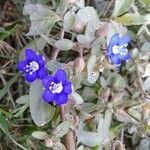Decumbent, ascending or prostrate subsucculent herb, rooting at the nodes; branches hollow, ± erect, 15–45(–150) cm. long.. Leaf-blade elliptic, elliptic-oblong or lanceolate, 1.5–12 cm. long, 0.6–2.5 cm. wide, acute at the apex, cuneate at the base, usually glabrous; petiole 2–5 mm. long.. Flowers in axillary false racemes or terminal panicles, ± glandular-pubescent; pedicels 3–6 mm. long.. Sepals lanceolate, 5–7 mm. long, glabrous or ± glandular pubescent and with scabrid margins, a little accrescent to 7.5 mm. in fruit and tips narrowly rounded or bluntly acute but not acuminate.. Corolla gentian blue with white tube; lobes ovate, ± 4 mm. long, 3 mm. wide.. Stamens with filaments 2–4 mm. long, the dilated part not very marked; anther 2 mm. long with very evident basal lobes.. Ovary oblong-ovoid, finely pubescent at apex; styles 1–2 mm. long.. Capsule globose, 4–5 mm. long, with septicidal or irregular dehiscence.. Fig. 1/9–14.
Herbs, erect to prostrate, sometimes rooting from lower nodes, 10-60(-100) cm tall, often branched, glabrous or pubescent, unarmed. Leaf blade lanceolate to ovate, 2-10 X 0.5-2.5 cm, glabrous or pubescent, base acute, margin entire, apex acute. Flowers in terminal panicles or clusters at branch apices, rarely solitary. Pedicel 1-3 mm, elongating after anthesis. Calyx lobes lanceolate, 4.5-8 mm, pubescent or glabrous. Corolla purple-blue or deep purple-green, 3-5 mm; tube white. Anthers scarlet. Capsule ovoid, septicidal or irregularly dehiscent, included in persistent calyx. Seeds oblong-ovoid, 0.3-0.4 mm. 2n = 18, 24.
An annual herb. It can be erect or lie over. It can root from the lower nodes. It grows 10-60 cm tall. The leaves have stalks. The leaves are alternate and 1-6 cm long by 0.2-1.3 cm wide. They are oval. Leaves narrow towards the base. The flowers are blue. They occur in clusters at the end of the branches. The seeds are oblong and 0.3-0.4 mm long.




